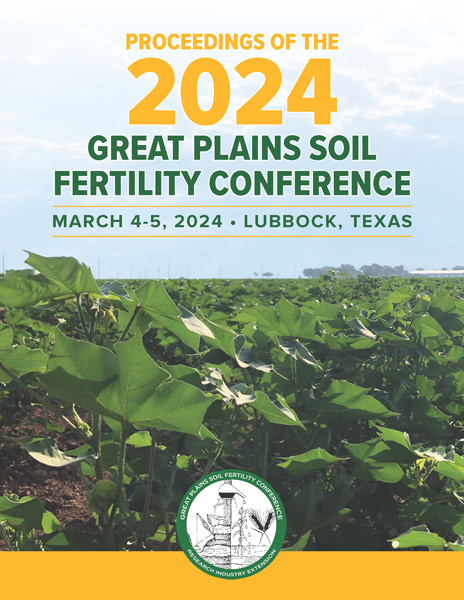Conference Proceedings Available!
Proceedings
Authors
| Filter results7 paper(s) found. |
|---|
1. Assessment of Long-term Effects of Tillage and Nitrogen Management Practices on Irrigated Corn Yields and Nitrogen Use EfficienciesCorn grain yields and crop nitrogen uptake are affected by management factors such as tillage intensity and nitrogen rates. Additional data about the long-term effects of tillage and nitrogen rates on yields and nitrogen use efficiencies of irrigated corn are needed. We are presenting preliminary results from a 17-year study about the effects of these management practices on irrigated corn yields and nitrogen uptake in a Fort Collins clay loam soil at Colorado State University’s Agricultural... J.A. Delgado, A. Halvorson, A. Villacis-aveiga, S. Del grosso, C. Stewart, D. Manter, J. Alwang, B. Floyd, R. D'adamo, G. Miner |
2. Tillage and Nitrogen Rates Influenced Wheat and Sorghum ProductivityReduced tillage (RT) or no-tillage (NT) practices and reducing fallow frequency can both decrease soil losses from wind erosion and conserve soil water in the semiarid regions of the US Great Plains. This study evaluated sorghum grain yield in 2013 and wheat grain yield in 2014 and 2015 as influenced by long-term nitrogen (N) fertilizer application rates (0, 20, 40, and 60 lb N ac- 1) and tillage intensity [clean tillage (CT), RT, and NT] in dryland winter wheat–sorghum-fallow (W-S-F) cropping... M. Mikha |
3. Investigating Relationships Between Haney H3a-4 and Conventional Soil Tests for Plant Nutrients in Kansas SoilsUse of a soil test to determine fertilizer application rates requires correlation and calibration to crop yield response and/or total nutrient uptake. The Haney H3A soil test procedure has gained popularity in recent years for soil health evaluation and has been used in some circles to adjust fertilizer management practices. However, data relating this test to current soil fertility tests, relative crop yield, or total nutrient uptake are nonexistent in Kansas soils. The objective of this study... B. Rutter, D. Ruiz diaz |
4. Evaluation of Mehlich-3 for Determination of Cation Exchange Capacity in Kansas SoilsSoil testing laboratories across the United States have implemented the Mehlich-3 (M3) extraction method for phosphorus (P) and other nutrients. Though M3 is known to work well as a multinutrient extractant, it raises concerns for measuring exchangeable cations, particularly in calcareous soils. The objectives of this study were (a) to evaluate M3 as an extractant for base cations for Kansas soils, (b) to identify a range of soil pH where M3 may be a suitable replacement for ammonium acetate... B. Rutter, D. Ruiz diaz |
5. Lime Management in the Semi-arid Regions of the USSoil acidity is increasing in the semi-arid regions of the US; however, questions exist about the efficacy of different liming products to raise soil pH and how long the lime benefits last. Therefore, we conducted two studies: 1) To monitor the efficacy of three liming products: sugarbeet lime (tilled and non-tilled), prilled lime (seed-placed), and aglime (tilled) to improve soil pH and crop yields at two sites in Montana and 2) To evaluate how different sugarbeet lime rates perform to mitigate... M. Rakkar, C. Jones, P. Miller, K. Mcvay, R. Engel |
6. Cover Crop Termination Timing Effects on Soil and Cotton Nutrient AvailabilityCover crop termination timings can have large impacts on the amount of soil coverage, nutrient availability, and stored soil moisture in a system. Producers in semi-arid regions must gamble the possibility of increased soil infiltration and reduced soil water evaporation against the potential of decreased soil moisture; in the SHP, success is dependent on irrigation capacity and precipitation. Optimizing termination timings for semi-arid regions and in deficit-irrigation/dryland systems is critical... C. Cobos, G. Baath, J. Burke, S. Chatterjee, P. Delaune, K. Lewis |
7. Sustainable and Resilient Cropping Systems to Mitigate Wind Erosion for the Enhancement of Human HealthIn the Texas High Plains, regenerative cropping practices in a predominantly conventional farming area can be used to prevent further depletion of topsoil by wind erosion. This loss of topsoil can cause a decrease in agricultural productivity and form dust storms that can be detrimental to human health causing a rise in hospitalizations of chronic lung damage, cardiovascular disorders, and diseases contracted by inhalation. Using regenerative farming practices, both the number and size of dust... K. Lewis, R. Babcock, J. Burke, C. Cobos |
